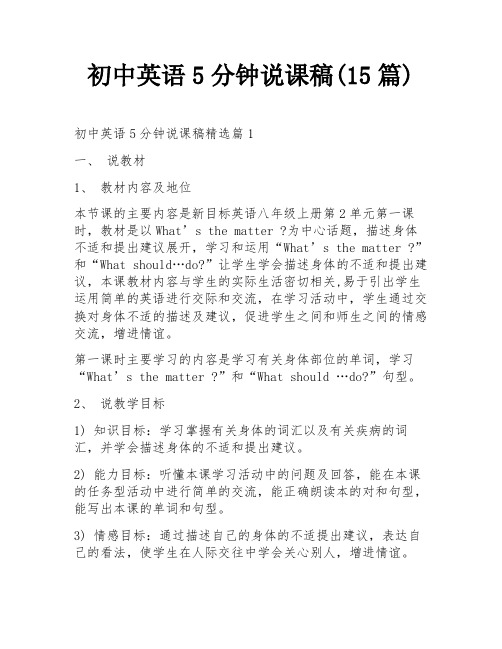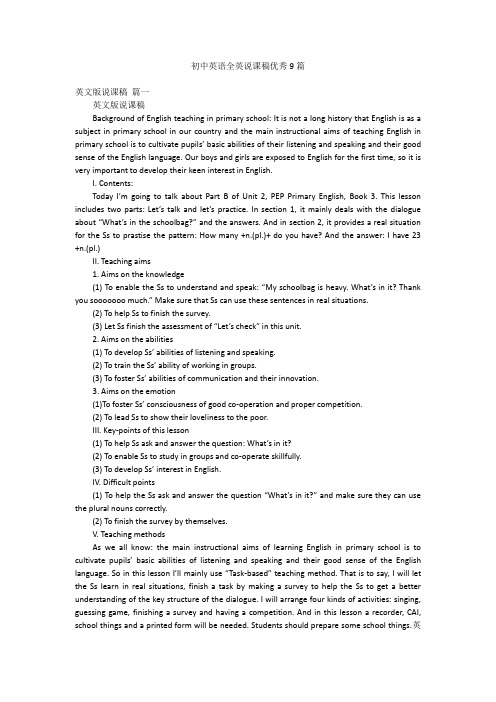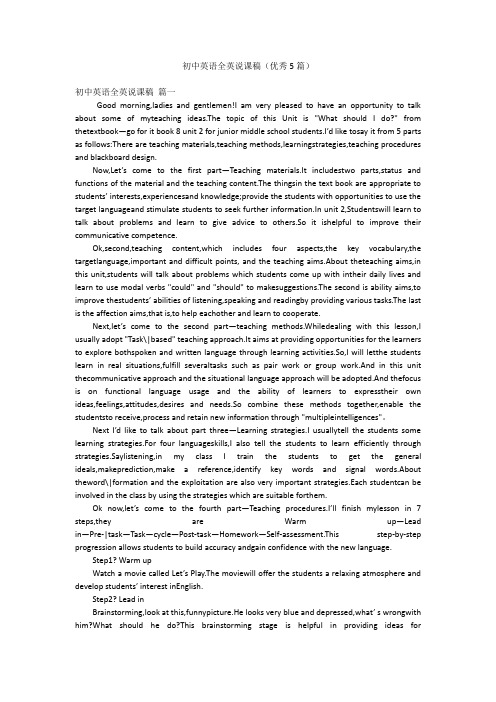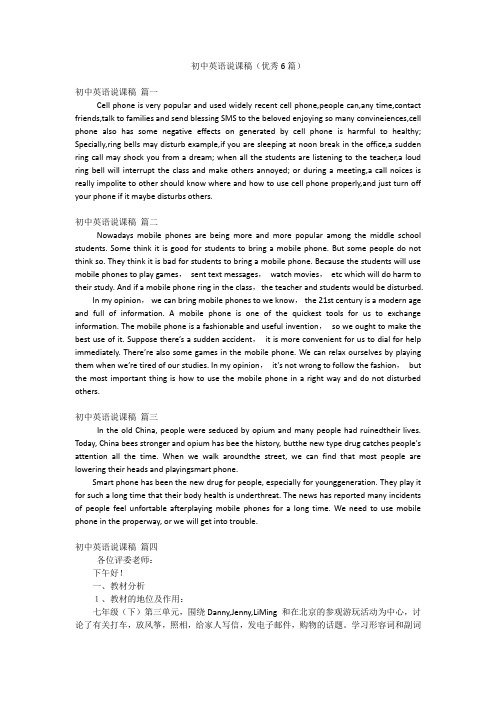初中英语优秀说课稿大集合精华版
- 格式:doc
- 大小:144.00 KB
- 文档页数:46

初中英语5分钟说课稿(15篇)初中英语5分钟说课稿精选篇1一、说教材1、教材内容及地位本节课的主要内容是新目标英语八年级上册第2单元第一课时,教材是以What’s the matter ?为中心话题,描述身体不适和提出建议展开,学习和运用“What’s the matter ?”和“What should…do?”让学生学会描述身体的不适和提出建议,本课教材内容与学生的实际生活密切相关,易于引出学生运用简单的英语进行交际和交流,在学习活动中,学生通过交换对身体不适的描述及建议,促进学生之间和师生之间的情感交流,增进情谊。
第一课时主要学习的内容是学习有关身体部位的单词,学习“What’s the matter ?”和“What should …do?”句型。
2、说教学目标1) 知识目标:学习掌握有关身体的词汇以及有关疾病的词汇,并学会描述身体的不适和提出建议。
2) 能力目标:听懂本课学习活动中的问题及回答,能在本课的任务型活动中进行简单的交流,能正确朗读本的对和句型,能写出本课的单词和句型。
3) 情感目标:通过描述自己的身体的不适提出建议,表达自己的看法,使学生在人际交往中学会关心别人,增进情谊。
4) 文化意识目标:用恰当的方式表达自己的看法,增进人际交往中学会关心别人的能力,了解英美国家询问和表达身体不适的习惯,培养世界意识。
3、说教学重难点重点:本节课主要学习身体部位的单词和一些疾病的词汇,以及身体不适的表达及建议。
难点:身体不适的表达及建议二、说学情初二年级的学生对英语已经有了一定的基础,但本地区部分学生对学习英语的兴趣不是很浓,在学习中,他们更喜欢从游戏中或活动中学习,这样更能提高他们的学习兴趣,让他们更轻松地掌握英语知识。
三、说教法作为教学的引导着,我遵循新课程“学生是学习的主人,一切的教学活动设计在以学生为本”的教学理念,坚持“为学生的发展,必须培养学生的自主性、能动性、独立性和创造性”的教学原则。

初中英语全英说课稿优秀9篇英文版说课稿篇一英文版说课稿Background of English teaching in primary school: It is not a long history that English is as a subject in primary school in our country and the main instructional aims of teaching English in primary school is to cultivate pupils’ basic abilities of their listening and speaking and their good sense of the English language. Our boys and girls are exposed to English for the first time, so it is very important to develop their keen interest in English.I. Contents:Today I’m going to talk about Part B of Unit 2, PEP Primary English, Book 3. This lesson includes two parts: Let’s talk and let’s practice. In section 1, it mainly deals with the dialogue about “What’s in the schoolbag?” and the answers. And in section 2, it provides a real situation for the Ss to prastise the pattern: How many +n.(pl.)+ do you have? And the answer: I have 23 +n.(pl.)II. Teaching aims1. Aims on the knowledge(1) To enable the Ss to understand and speak: “My schoolbag is heavy. What’s in it? Thank you sooooooo much.” Make sure that Ss can use these sentences in real situations.(2) To help Ss to finish the survey.(3) Let Ss finish the assessment of “Let’s check” in this unit.2. Aims on the abilities(1) To develop Ss’ abilities of listening and speaking.(2) To train the Ss’ ability of working in groups.(3) To foster Ss’ abilities of communication and their innovation.3. Aims on the emotion(1)To foster Ss’ consciousness of good co-operation and proper competition.(2) To lead Ss to show their loveliness to the poor.III. Key-points of this lesson(1) To help Ss ask and answer the question: What’s in it?(2) To enable Ss to study in groups and co-operate skillfully.(3) To develop Ss’ interest in English.IV. Difficult points(1) To help the Ss ask and answer the question “What’s in it?” and make sure they can use the plural nouns correctly.(2) To finish the survey by themselves.V. Teaching methodsAs we all know: the main instructional aims of learning English in primary school is to cultivate pupils’ basic abilities of listening and speaking and their good sense of the English language. So in this lesson I’ll mainly use “Task-based” teaching method. That is to say, I will let the Ss learn in real situations, finish a task by making a survey to help the Ss to get a better understanding of the key structure of the dialogue. I will arrange four kinds of activities: singing, guessing game, finishing a survey and having a competition. And in this lesson a recorder, CAI, school things and a printed form will be needed. Students should prepare some school things.英文版英语说课稿VI. Teaching procedures and purposes of my designing.I’ll finish this lesson in five steps.Step 1. Warm-up and preview1. Free talk between T and Ss about things in the classroom.2. Sing the song together: Books and pencils.3. Do some TPR, for example: Show me your English book. Show me your crayon.4. Review the numbers by asking: “How many crayons do you have?”Purpose: It is important to form a better English learning surrounding for the Ss by singing and doing some total physical response and at the same time it provides situations to review learned knowledge for the next step.Step 2. PresentationNow I’ll mainly talk about this step.1. Present the pattern: “My schoolbag is heavy.” “What’s in it?.”(1) Show a bag and say: “Look! I have a bag.” Carry it and say: “Oh, it is heavy. My schoolbag is heavy.” Help the Ss understand the meaning with the help of my body language. Then lead the Ss to read the sentence. Make sure they can say it correctly.(2) T: My schoolbag is heavy.Open the bag and say: “What’s in it? What’s in my schoolbag?”Take out a Chinese book. Then do the action again. Let the Ss read the sentence.2. Play a guessing game. Divide the whole class into four groups to have a competition.Let them guess: What’s in the bag? How many? Purpose: To present the key structures one by one is much easier for the Ss to learn and grasp the meanings. Proper competition can arouse the Ss’ interest in English learning.3. With the help of the CAI to present the dialogue. Set a situation to help Ss understand: Two Ss are coming. One girl is carrying a heavy bag on her back. They are talking.Girl: My schoolbag is heavy.Boy: What’s in it?Girl: 20 story-books, 32 pencil, 9 rulers, 12 crayons and 30 picture-books. Etc.Boy: What will you do?Girl: They are for the poor.Boy: Great! I’ll bring some school things too.The boy comes back home and puts a lot of things into the bag. Then he goes to school again and gives them to a teacher. While he is taking them out, he is counting the numbers of all things. The teacher says: Thank you soooooooo much.4. Mention that we should take care of the poor.5. Play the cassette. Let the Ss listen and imitate the dialogue.Pay attention to their pronunciation and intonation. Purpose: CAI can provide a real situation for the Ss to understand the dialogue and the relationships between people better. Tell the Ss we should show our loveliness to the Ss.Step 3. PracticeDivide Ss into groups of six children. Each one would finish the printed form by asking and answering: How many storybooks do you have? Find out which group finishes faster. Story books picture-books sharpeners crayons pencils erasers pencil-cases rulers Chen Jie 8 24 3 32 26 4 1 3Purpose: Task-based teaching method is used here to develop Ss’ ability of communication and also their ability of co-operation will be well trained.Step 4. AssessmentHelp Ss finish “Let’s check” of this unit and workbook.Purpose: To check the knowledge Ss have learned in this period.Step 5. Add-activity1. Let Ss tell each other how many school things they have after class. Tell their parents how many school things they have at home.2. Take care of everything they have.Purpose: Revision is so important that Ss should speak English as much as they as in class or after class. It is necessary for the Ss to do some extensive exercises after class to consolidate the knowledge they learned.英文版英语说课稿初中英语说课稿篇二今天我的说课内容是新目标英语八年级上册第四单元第一课时。

初中英语说课稿初中英语说课稿(通用11篇)说课活动分课前说课和课后说课两种形式,不论是课前说课还是课后说课上述内容必须阐述清楚。
以下是公文站小编整理的关于初中英语说课稿范文。
欢迎大家参考!初中英语说课稿篇1我说的是七年级英语第一学期第四单元第29课—Let’s eat! Let’s drink!这一课,我将从以下四个方面谈谈:一、教材分析第29课位于本册书第四单元第五课,第四单元以“Food and Restaurants”展开学习,主要帮助学生掌握一日三餐的表达法,英语国家中最常见的饮料与食品的名称及数字11到20的读写法。
通过学习让学生了解一些西方饮食习惯并能用简单的英语在就餐时进行交谈,学会表达“喜欢与不喜欢”,“谈论价格”等,在此基础上区分可数名词与不可数名词,了解行为动词的一般现在时态,逐步培养学生乐于接触异国文化的情趣。
本课主要学习饮料的名称及计量单位,数字16到20,并以一首歌曲来复习食物名称。
根据其内容与第27课联系较紧密,我将设计在上完27课后跳过28课先上这一课,以此来加深学生对系统知识的巩固。
通过学习,本课的教学重点是让学生牢固掌握词汇和短语:sixteen, seventeen, eighteen, nineteen, twenty, melon, coke, juice,coffee, cup, a cup of, bottle, a bottle of, can, a can of, glass, a glass of;唱会歌曲“It’s time for lunch.”教学的难点在于进一步让学生区分可数名词与不可数名词。
二、教法设计为了突出本课的教学重点,突破本课的教学难点,体现本课的教学目标,取得较好的教学效果,在整个教学活动中我将运用多媒体教学手段采用谈话法、问题教学法、展示法、范例教学法、重点解释、个别操练、指导学生展开情景对话、探讨语言知识的教学法,我还设计了翻译练习和数字练习题,以检查学生对一、二部分的掌握情况。

初中英语说课稿(集锦15篇)初中英语说课稿1一、说教材本单元以“A picnic”为话题,共设计四大部分的内容。
以It must belong to carla为主线,围绕谈论某东西属于某人等语言功能展开一系列任务活动。
通过第一部分的学习要求学会如何进行推测,并了解学会基本句型的应用。
教材内容从基本语言知识到语言综合知识的运用,层层递进,以一种循序渐进的生活化的语言程序,引导学生在做事中有目的的学习语言。
教学目标:知识目标:能够让学生掌握重点的词汇和语言结构。
能力目标:培养学生听、说、读、写能力和观察事物的能力。
情感目标:培养学生在外野营时,不能乱扔。
乱丢垃圾的良好习惯,以确保环境的干净和清洁。
二、说教法以任务教学策略为主,采用情景教学法、听力训练法、并辅助个人,小组竞赛和图片等兴趣策略教学。
如在教授单词时,通过一些图片等进行分析教学,以至于从视角引起他们的注意,从而记注单词。
采取任务型教学策略的目的是让学生多练多用,在做中学,学中乐,乐中掌握。
三、说学法采用合作式学习方式,有目的的让学生预习,在完成任务的活动中主动的学习语言。
养成继续学习英语、学好英语的良好习惯。
并让学生学会如何推测,以至于在做推测性的阅读题时有很好的方法。
强调学生不仅在课上积极发言、多练,并鼓励他们课后成立英语学习兴趣小组、英语角等,积极参加训练。
四、说教学过程1、课前任务设置。
在每一节课,我让学生提前预习,课前三分钟,我让学生学唱“Are you sleeping ”的歌曲。
目的是激发他们的学习热情。
另一方面,铃声响的时候,首先检查学生对第四单元的识记情况。
然后让学生看屏幕,用“Who is he ?” 句子问,用“It can?t、may 、must be ”等回答,之后通过“Look and learn”推出新单词“belong、belong to” 和教授的单元。
在此期间,让学生感知的重点句型结构。
把单词的教学融入句型,培养学生情景中理解单词的能力。

初中英语全英说课稿(优秀5篇)初中英语全英说课稿篇一Good morning,ladies and gentlemen!I am very pleased to have an opportunity to talk about some of myteaching ideas.The topic of this Unit is "What should I do?" from thetextbook—go for it book 8 unit 2 for junior middle school students.I’d like tosay it from 5 parts as follows:There are teaching materials,teaching methods,learningstrategies,teaching procedures and blackboard design.Now,Let’s come to the first part—Teaching materials.It includestwo parts,status and functions of the material and the teaching content.The thingsin the text book are appropriate to students’ interests,experiencesand knowledge;provide the students with opportunities to use the target languageand stimulate students to seek further information.In unit 2,Studentswill learn to talk about problems and learn to give advice to others.So it ishelpful to improve their communicative competence.Ok,second,teaching content,which includes four aspects,the key vocabulary,the targetlanguage,important and difficult points, and the teaching aims.About theteaching aims,in this unit,students will talk about problems which students come up with intheir daily lives and learn to use modal verbs "could" and "should" to makesuggestions.The second is ability aims,to improve thestudents’ abilities of listening,speaking and readingby providing various tasks.The last is the affection aims,that is,to help eachother and learn to cooperate.Next,let’s come to the second part—teaching methods.Whiledealing with this lesson,I usually adopt "Task\|based" teaching approach.It aims at providing opportunities for the learners to explore bothspoken and written language through learning activities.So,I will letthe students learn in real situations,fulfill severaltasks such as pair work or group work.And in this unit thecommunicative approach and the situational language approach will be adopted.And thefocus is on functional language usage and the ability of learners to expresstheir own ideas,feelings,attitudes,desires and needs.So combine these methods together,enable the studentsto receive,process and retain new information through "multipleintelligences"。

初中英语说课稿(优秀6篇)初中英语说课稿篇一Cell phone is very popular and used widely recent cell phone,people can,any time,contact friends,talk to families and send blessing SMS to the beloved enjoying so many convineiences,cell phone also has some negative effects on generated by cell phone is harmful to healthy; Specially,ring bells may disturb example,if you are sleeping at noon break in the office,a sudden ring call may shock you from a dream; when all the students are listening to the teacher,a loud ring bell will interrupt the class and make others annoyed; or during a meeting,a call noices is really impolite to other should know where and how to use cell phone properly,and just turn off your phone if it maybe disturbs others.初中英语说课稿篇二Nowadays mobile phones are being more and more popular among the middle school students. Some think it is good for students to bring a mobile phone. But some people do not think so. They think it is bad for students to bring a mobile phone. Because the students will use mobile phones to play games,sent text messages,watch movies,etc which will do harm to their study. And if a mobile phone ring in the class,the teacher and students would be disturbed.In my opinion,we can bring mobile phones to we know,the 21st century is a modern age and full of information. A mobile phone is one of the quickest tools for us to exchange information. The mobile phone is a fashionable and useful invention,so we ought to make the best use of it. Suppose there’s a sudden accident,it is more convenient for us to dial for help immediately. There’re also some games in the mobile phone. We can relax ourselves by playing them when we’re tired of our studies. In my opinion,it’s not wrong to follow the fashion,but the most important thing is how to use the mobile phone in a right way and do not disturbed others.初中英语说课稿篇三In the old China, people were seduced by opium and many people had ruinedtheir lives. Today, China bees stronger and opium has bee the history, butthe new type drug catches people's attention all the time. When we walk aroundthe street, we can find that most people are lowering their heads and playingsmart phone.Smart phone has been the new drug for people, especially for younggeneration. They play it for such a long time that their body health is underthreat. The news has reported many incidents of people feel unfortable afterplaying mobile phones for a long time. We need to use mobile phone in the properway, or we will get into trouble.初中英语说课稿篇四各位评委老师:下午好!一、教材分析1、教材的地位及作用:七年级(下)第三单元,围绕Danny,Jenny,LiMing 和在北京的参观游玩活动为中心,讨论了有关打车,放风筝,照相,给家人写信,发电子邮件,购物的话题。
初中英语说课稿优秀8篇初中英语说课稿篇一一、教材分析:教材概述:《新目标英语》Go for it !每个单元包括section A , section B,跟self check三个,部分其中A 部分是基本的语言内容,B部分是知识的扩展跟综合的语言运用。
Self check 部分是让学生用来自我检测本单元所学的语言知识。
教材突出语言使用能力的培养,它采用任务型语言教学模式,每个单元都设计成一个或几个与该单元话题有关的任务,让学生在完成任务的过程中,使用英语获取信息,进行交流,真正体现了在“在做中学”“在学中用”的教学理念。
单元内容分析:本单元的标题为This is my sister ,教材以family members 为中心话题,围绕着“介绍家人跟朋友”展开,学习跟运用目标语言“介绍人物跟识别人物”本单元的教学内容:1.掌握词汇father ,mother ,grandfather, grandmother , brother ,sister , cousin ,daughter ,son ,uncle ,aunt ,parent(s),grandparent(S)friend. 等2.补充词汇husband wife son-in-law daughter-in-law mother-in -law father-in -law, nephew , niece等3.介绍他人的句型This/That is… , These/Those are…4.询问,辨认人物的疑问句形式Is this/that…?二、教学设计思路《新目标英语》中的具体语言目标是通过各种各样的tasks来实现的,学生需要运用具体而特定的行动来完成一定的交际任务,整个教学过程中就是各种语言结构与语言功能与不同的学习任务有机的结合,因此,本单元我将始终引导学生通过完成具体的任务活动来学习语言,让学生为了特定的学习目的去实施特定的语言行动,通过完成特定的交际任务来获得跟积累相应的学习经验,让学生在用中学,在学中用。
初中英语说课稿精选(全英文版)Good morning。
everyone。
My name is Zhang Meiying and I am from Huishe Middle School。
It is an honor to be here today to present my lesson on "Sports Star Eats Well"。
My n will be divided into six parts:Part 1: Analysis of the teaching materialPart 2: Analysis of the target studentsPart 3: Analysis of the teaching methodsPart 4: Analysis of study techniquesPart 5: Analysis of teaching resPart 6: Blackboard designNow。
let's begin with Part 1.the analysis of XXX。
The lesson I will be teaching is the fourth d of Unit 6.The main focus of this lesson is on likes and dislikes。
specifically related to food。
It is important for students to understand the status and n of this lesson.Teaching aims and demands XXX: knowledge aims。
ability aims。
and nal aims。
The knowledge aims of this lesson are to help students master new XXX "star," "eat," "well," "habit," "healthy," "really," "n," "want," and "fat." nally。
初中英语全英说课稿优秀8篇(经典版)编制人:__________________审核人:__________________审批人:__________________编制单位:__________________编制时间:____年____月____日序言下载提示:该文档是本店铺精心编制而成的,希望大家下载后,能够帮助大家解决实际问题。
文档下载后可定制修改,请根据实际需要进行调整和使用,谢谢!并且,本店铺为大家提供各种类型的经典范文,如总结报告、演讲发言、策划方案、合同协议、心得体会、计划规划、应急预案、教学资料、作文大全、其他范文等等,想了解不同范文格式和写法,敬请关注!Download tips: This document is carefully compiled by this editor. I hope that after you download it, it can help you solve practical problems. The document can be customized and modified after downloading, please adjust and use it according to actual needs, thank you!Moreover, our store provides various types of classic sample essays, such as summary reports, speeches, planning plans, contract agreements, insights, planning, emergency plans, teaching materials, essay summaries, and other sample essays. If you want to learn about different sample formats and writing methods, please pay attention!初中英语全英说课稿优秀8篇说课活动分课前说课和课后说课两种形式,不论是课前说课还是课后说课上述内容必须阐述清楚。
初中英语优秀的说课稿范文(通用18篇)初中英语优秀的说课稿范文(通用18篇)作为一名人民教师,时常需要编写说课稿,编写说课稿助于积累教学经验,不断提高教学质量。
说课稿应该怎么写才好呢?以下是小编为大家收集的初中英语优秀的说课稿范文,欢迎阅读与收藏。
初中英语优秀的说课稿篇1一、说教材:1、教材简析:我说课的内容是江苏牛津中学英语教材9A第3单元T eenage problems中的Integrated skills部分。
本单元通过青少年中存在的问题和困扰这一主题,引出话题,谈论话题。
由于学生对这一话题极感兴趣,我在教学中准备使用多种教学手段设置情景,有效地把单词和句型情景相结合,注重听说训练,使语言点的训练密切联系生活实际,达到灵活运用,学以致用的目的。
2、教学目标:依据英语新课标所提出的总目标并根据本年段学生认知水平,我制定了如下教学目标:a、能听懂、会说、会读和会拼写单词和词组。
b、能听懂、会说、会读和会写句型。
c、能正确地听懂、掌握A板块前半部分听力内容,并能以较好的语音语调流畅地朗读后半部分的课文填空。
d、能用本课所学语言讨论青少年中存在的问题3、教学重点、难点:教学重点:正确拼读本课四会单词和句型,能流利地用所学句型进行情景会话。
二、说教法和学法根据我对《英语课程标准》的理解和九年级学生的生理和心理特点,我将教学本课的指导思想确定为:让学生主体参与,主动探究,合作互动,充分发展。
具体采用如下教学方法:1、情景教学法:通过设置较为真实的情景,使学生产生身临其境的感觉,激起学生情感上的共鸣,从而引导学生从整体上理解和运用语言,促进学生的语言能力及情感、意志、想象力、创造力等整体发展。
2、小组学习法:每4人一组,可两两交流,也可自由选择,在互动中互相启发发生思维的碰撞。
同时注意保证每个学生都有机会参与学习,培养学生与伙伴合作的意识和策略,提高人际交往能力。
3、练习法:把大多课堂时间留给学生,使学生在多信息、高密度、快节奏的灵活操练中拓宽学习渠道。
初中英语优秀说课稿之一A Brief Instruction to the topic of “What should I do?”Good afternoon, ladies and gentlemen. My name is LiYiCai. I come from Shangyuan Middle School in Nanjing.Today I’m going to talk about the topic” What should I do?”I will divide the instr uction into seven parts:they are Teaching material Analysis, Teaching aims, Teaching emphasis, Teaching difficulties, Teaching methods, Teaching aids and Teaching procedures.Part 1 Teaching material analysisThis period is from Unit 3 of 9A Oxford Englis h. First of all,I’d like to talk about my understanding about this lesson.We have learned Star sings in Unit 1 and Colours and moods in Unit 2.We have also learned how to write a formal recommendation letter and how to write a report on the moods of people in last two units.Today we are going to learn two letters to a famous youth worker about Millie’s and Simon’s problems.So this unit links with a special meaning of Unit 1 and Unit 2.This period is the first lesson of Reading.The main idea of the topic is how to express their problems and ask for advice.We are going to learn the ways to deal with problems and stress in following lessons.So this period is very important in this unit.Part 2 Teaching aims1.Aims of the knowledge:(1)To know the spelling of some words and usage of some phrases.(2)To learn something about Millie’s and Simon’s problems.(3)To grasp the main idea of Reading and use the information to talk to others about one’s problems and how to deal with them.2.Aims of the ablilities:(1)To improve the ability of getting information by reading.(2)To improve the ability of retelling the story.3.Aims of the emotion:(1)To understand how to write about problems and to express feelings.(2)To ask for advice to solve the problems.Part 3 Teaching emphasis1.To master the ‘to’-infinitives and‘wh-’words+‘to’-infinitives.2.To get the ability of general reading and getting information.Part 4 Teaching difficulties1.To recognize and understand vocabulary about problems.2.To ask for advicePart 5 Teaching methodsIn this topic,I will use five-step Teaching Method and Task-based language Teaching.I design some tasks to help the students learn.I think if I want to improve the students’ oral English,I should give them enough chances to practice and I will use pair work,group work to let the studentstake an active part in all kinds of activities.That is “Learning by doing,learning by using”.Let the students be the masters of the class teaching,thus,student-centered teaching method is well shown.Part 6 Teaching aidsProjector,slide show,tape recorder and blackboardPart 7 Teaching procedureStep Ⅰ.Lead-inThe purpose is to arouse the students’interest of study.Let’s have a free talk.T:Have you got problems?S:Yes.T:What is it?S:Eating too much makes me unhealthy.T:What about you?S:……Step Ⅱ.PresentationThe purpose is to develop the skills of skimming and how to gain the main idea of the articles.1.Ask students to read two letters and answer the following questions:①What is Millie’s favo rite hobby?(Painting)②What is Millie’s problem?(She doesn’t have enough time for hobbies and home work.)③When does Simon play football?(After school until late)④How do his parents feel about it?(They don’t like this and ask him to go home before 6 p.m.)2.Ask students if there are words that they do not know.Explain some new words briefly.deal;choice;complete;refuse;accept;spare;doubt;whether;Step Ⅲ.PracticeThe purpose is to develop the skills of scanning and how to gain the details from the articles.1.Listen to the tape and answer some question about“True”or“False”.2.Ask students to read the articles again and explain some important phrases.How to solve the problems;hand in;on time;at the moment;can’t find any time for my hobbies;feel bad;give up;achieve a balance between the two;hear form;make unhappyStep Ⅳ.RetellingThe purpose is to develop the skills of retelling with the key words1.Ask students to make sentences with phrases that we have learned.2.Try to retell the outline of the articles.3.Encourage students to say something about themselves.Step Ⅴ.Summary and homeworkThe purpose is to give the students a clear idea of how to express their problems and revise the articles.1.Ask students to revise the words and phrases2.Ask students to write a letter about himself after class.During my teaching,I’ll try my best to get my class alive and encourage the students to talk with each other in English. I think the general aim of English teaching is to improve the ability of using English.A nd I’ll use this to guide my teaching.Thank you!初中英语优秀说课稿之二一、说教材(教材分析) Analyzing teaching material1. 说课型 lesson type (Dialogue/ reading/ listening/ revision)2. 本课在教材中的地位 status and functionLesson 33 Saving the Earth is a dialogue. The lesson is focused on the topic of the problems of the earth and the functional items of Supposition/ Intentions/ conjecture/ Prohibition. Since it is a dialogue / reading. It’s helpful to improve the Ss communicative/ reading ability.3. 说教学指导思想 teaching guideline(Teaching syllabus: Language is for communication, develop their four skills, lay special emphasis on reading; Grellet put it well in his book developing reading skills: develop reading skill/ discourse analysis; get them to understand the western culture better; improve the ability to discover, analyze & solve the problems; Reading is for information, for fun; Use Top- down model or Bottom- up model to activate Ss schemata; Interactive model)4. 说教学目标和要求Teaching aims and demands (…be intended for Ss in key schools)1)认知目标 knowledge objectsa. Enable the Ss to remember the following new words & phrases:Damage, lecture, pollute, pollution, room, standing room, be fit for, hear about, turn intob. Get the Ss to be familiar with this sentence pattern:If the population keeps growing so quickly, there will only be standing room left…Give the Ss a reinforced practice on the functional item Supposition.c. Activate Ss schemata regarding the topic of pollution and help Ss to know more about the problem of pollution.2)智能目标 ability objectsa. Ask the Ss to make up a similar dialogue.b. Help them to understand the dialogue better and improve the four skills.c. Develop their ability of thinking independently.d. Cultivate their ability to discover, analyze and solve problems.e. Train them to collect information from the Internet.f. Train them with some effective learning methods to optimize Ss’ learning results.3)德育目标 moral objectsa. Arouse their interest in learning English;b. Help them to understand the background of pollution.c. Enable the students to love our earth and the nature.d. Be aware of the importance of stopping pollution & protecting out environment.e. Encourage the Ss to do something to save the earth.5. 说教学重点 teaching important points (生词、句型;培养阅读技能)a. New words and phrasesb. Sentence pattern: If- clausec. improve their reading skills.d. Talking about problems of the Earth.6. 说教学难点 teaching difficult points (语法;发展交际能力)a. functional item: Supposition.b. Develop their communicative ability. Act out their own dialogue.7. 说教具 teaching aids (multi-media computer, software, OHP)The teaching syllabus says that it’s necessary for teachers to use modern teaching facilities. It’s of great help to increase the class density and improve our teaching result. It can also make the Ss reach a better understanding of the text by making the classes lively and interesting. At the same time, it arouses the Ss’ interest in learning English.二、说教法 Teaching methodsFive step method; audio-video; communicative approach;Task-based learning: New Syllabus Design encourages teachers to use this teaching method. TBLT can stimulate Ss’ initiative in learning and develop their ability in language application. Make the Ss the real masters in class while the teacher himself acts as the director and bring their ability into full play.三、说学法 Study methods1. Teach Ss how to be successful language learners.2. Teach Ss how to develop the reading skill — skim & scan; how to communicate with others; how to learn new words; how to learn independently;3. Get the Ss to form good learning habits.四、说教学过程Teaching proceduresI. 复习 (Revision) 5min (Daily report; 词汇diagram; brainstorming; activate schemata)Activity 1: Imagination1). Suppose a bottle of ink is turned over and dirties your white shirt, what is to be done? (Wash it? Or throw it away?)2). Suppose you catch a bad cold, what’s to be done?3). Suppose your bike is broken, what’s to be done?4). And suppose the earth, on which we all live, is damaged, what’s to be done?* What can you think of when you see “pollution” this word?(waste, environment, air, water, factory, desert, climate... Try to activate the Ss schemata regarding the topic of pollution.)II. 呈现 (Presentation) 5minActivity 2: PresentationPlay the song “Earth Song” sung by Michael Jackson. (Create an atmosphere)A lot of pictures and video clips about the causes and results of the three problems mentioned in this lesson will be shown on the screen with the help of the computer.Ss’ presentation on pollution. Attr act their attention, arouse their interest, and create a good atmosphere for communication.* Activate their schemata and cultivate their ability in collecting information from the Internet and develop their ability in thinking independently.III. 对话 / 阅读 (Dialogue)18m1. Pre- readingActivity 3: Prediction1st listening/ fast reading, one guided Q to help Ss to get the main idea:What do you think is discussed at the conference?2. While- readingActivity 4: Read and answer2nd listening/ careful reading, more Qs to get the detailed information. Develop their reading skills: skim & scan. Pay attention to the pronunciation, stress & intonation.* 阅读: Pre-reading; while-reading; post-reading (fast reading/ careful reading; skim/ scan; 识别关键词key words;确定主题句;创设信息差information gap;T or F; 填表格chart/diagram; Predicting; Make a timeline; Make a story map。